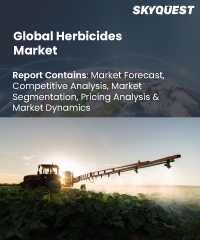
Product ID: SQMIG15A2110

Report ID:
SQMIG15A2110 |
Region:
Global |
Published Date: February, 2024
Pages:
157
|
Tables:
90 |
Figures:
76
Herbicides Market size was valued at USD 30.32 billion in 2019 and is poised to grow from USD 31.59 billion in 2023 to USD 45.75 billion by 2031, growing at a CAGR of 4.2% in the forecast period (2024-2031).
Herbicides are a type of pesticide that is used to suppress weeds during cultivation. Herbicides, often known as weedkillers, are classified into two types: selective and non-selective herbicides. Non-selective herbicides can be used to clear industrial and construction sites, railways, and railway ridges since they destroy all plant material with which they come into contact. Selective herbicides control specific weed species while leaving the desired crop intact. Herbicides are used to increase agricultural output by eradicating undesired plants and weeds in the plantation. As a result, the increased desire for high agricultural productivity to meet global food demands supports the expansion of the herbicides industry. Furthermore, the increase in population and disposable money in a growing region such as Asia-Pacific boosts the need for herbicides. However, the risks connected with synthetic herbicides result in tight herbicide regulations, which significantly impedes the growth of the global herbicides market.
US Herbicides Market is poised to grow at a sustainable CAGR for the next forecast year.
Our industry expert will work with you to provide you with customized data in a short amount of time.
REQUEST FREE CUSTOMIZATIONHerbicides Market size was valued at USD 30.32 billion in 2019 and is poised to grow from USD 31.59 billion in 2023 to USD 45.75 billion by 2031, growing at a CAGR of 4.2% in the forecast period (2024-2031).
Want to customize this report? This report can be personalized according to your needs. Our analysts and industry experts will work directly with you to understand your requirements and provide you with customized data in a short amount of time. We offer $1000 worth of FREE customization at the time of purchase.

Product ID: SQMIG15A2110